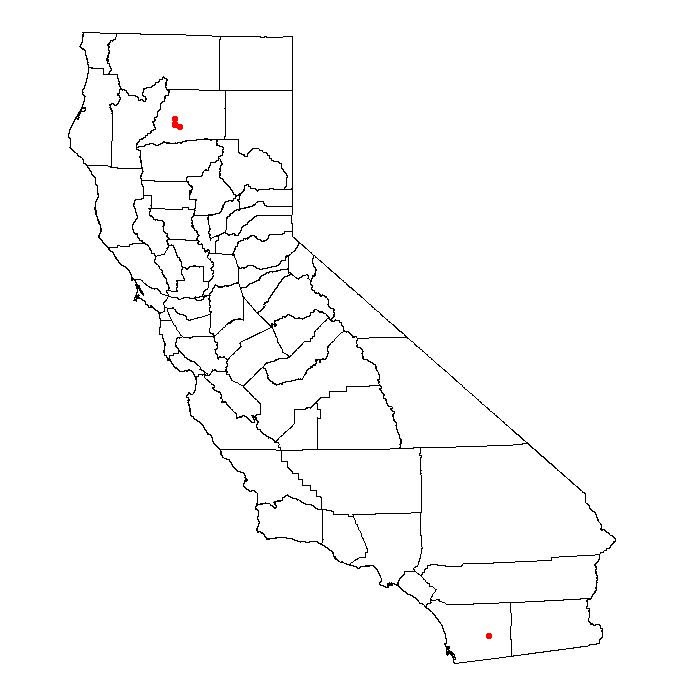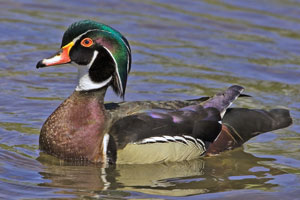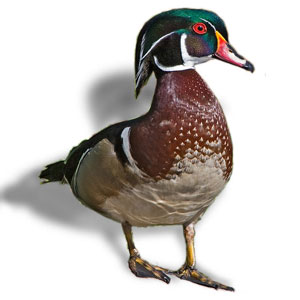
Home | About Us | Projects | Maps | Facts

Home | About Us | Projects | Maps | Facts

Wood Duck (Aix sponsa) Also known as the Woodie, Carolina duck, Swamp Duck, Squealer Duck and Summer Duck Description: Wood Duck drakes are the most vividly colored of all North American ducks. The head and crest are metallic green and purple, with a white line extending from the base of the bill above the eye and another behind the eye along the crest; the throat and neck are also white. The breast is chestnut with white flecks, and the lower breast and underparts are white. The mantle and wings are metallic blue and green; sides are buff, finely vermiculated with black. The drake has red eyes without an eye ring. His bill is red, with a yellow band at the base and a black line above the nostrils to the tip. Legs and feet are dark yellow. 
The hen is mostly brownish-olive overall, with white streaks on the breast, dark eyes, and tear-drop shaped white eye ring (see photos below). Her bill is much duller than the drakes, being dark gray overall. The legs and feet are dark yellow like the male.
Calls:
The drake's high-pitched whistle, "jeeeee" and the hen's low, owl-like "whoo-w-eet" call can be heard as they fly.
What do you call a group of ducks? Range/Habitat: The Wood Duck breeds from British Columbia south to California, and from Montana east to Nova Scotia and south to Texas and Florida. They are absent from Rocky Mountains and Great Plains. Winters near Pacific Coast north to Washington, and to New Jersey in East, rarely farther north. All ducks live near water. The wood duck, as its name implies, requires wooded cover for nesting. They prefer swamps and even upland forests close to freshwater wetlands, ponds, creeks, and rivers. Click the range map to learn more about the distribution of Wood Ducks in California. Diet: Wood ducks are mainly vegetarian, feeding on aquatic plants, seeds, nuts and fruits. They also eat insects, snails, tadpoles, and salamanders. Wood ducks are "dabbling" ducks and forage for food while swimming. 
Nesting: The breeding season for wood ducks begins in April. The hen will pull some of her down feathers out to line the nest hidden in a natural tree cavity or a man-made nest box. The nest can be up to 50' (15 m) off the ground. The Wood Duck's habit of nesting in cavities enables it to breed in areas lacking suitable ground cover and avoid predation of the young. The female lays a clutch up to 15 cream colored eggs. A normal clutch has 6-10 eggs. The hen incubates the eggs for 25 to 37 days. The young grow quickly and can fly at about 8 to 10 weeks. The female occasionally produces two broods per year. The young leave the nest soon after hatching. They jump from the nesting cavity, often high up in a tree, to the ground or water below. Conservation: The Wood Duck was hunted nearly to extinction during the late 19th and early 20th centuries. Hunting restrictions and wildlife management practices have been successful - there are now over a million Wood Ducks living in North America.
Did You Know?
Animal silhouettes available to purchase » Photos: Natures Pics Definitions: Brood - a family of young animals produced at one hatching or birth. Clutch - a number of birds hatched at the same time. Drake - adult male of a wild or domestic duck. Hen - adult female bird. Sexual dimorphism - the systematic difference in form between individuals of different sex in the same species. Examples include size, color, and the presence or absence of parts of the body used in courtship displays or fights, such as ornamental feathers, horns, antlers or tusks. |